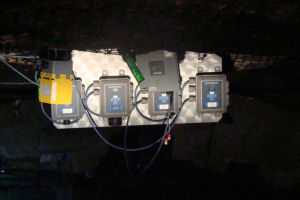Mining Topic: Atmospheric Monitoring
What is the health and safety problem?
The proper control and distribution of ventilation air in working areas of underground mines is crucial to the health and safety of mine workers. Many underground coal mines cover vast areas where workers are not located. Continuous knowledge of the ventilation system status, along with information on the presence of methane or products of combustion from fires, is critical for detecting and correcting problems in the mine atmosphere in their earliest stage.
To this end, various sensors can be used in targeted areas of the mine to collect environmental data on levels of combustible gas or products of combustion that may provide an early indication that heating is in progress. In addition to levels of combustible gas, monitoring airflow velocity and direction continuously can improve the safety of the underground workforce. However, continuous measurements of air velocity may not always provide accurate assessments of ventilation conditions, as these values can change rapidly depending on measurement location and airflow conditions.
What is the extent of the problem?
 Multiple gas sensors installed in a mine to collect mine atmospheric data
Multiple gas sensors installed in a mine to collect mine atmospheric data
Under MSHA regulations for atmospheric monitoring systems, monitoring in active mining areas usually involves methane and products of combustion around electrical and belt installations. Monitoring of ventilation airflow velocity is less common, with little information gathered on airflow direction. Large portions of many underground operations may not be continuously monitored for airflow velocity and methane accumulations.
How is the NIOSH Mining program addressing this problem?
NIOSH Mining investigated the use of ultrasonic velocity instrumentation in the underground mine environment. Ultrasonic anemometers are known for their accuracy, capability to measure low airflows, continuous measurement characteristics, and ability to provide a directional sign to the air velocity. This can be especially beneficial in situations with low air velocity in that airflow reversals may occur.
NIOSH research efforts focused on the installation of integrated airflow and methane monitors in active areas of underground coal mining operations. This work identified specific sampling protocols for these devices and assessed the behavior of these instruments in relation to the presence of airway obstructions such as personnel and equipment. NIOSH also identified potential applications and limitations of integrated air velocity and methane monitoring systems and developed guidelines to interpret air velocity and methane monitor outputs.
What are the significant findings?
NIOSH Mining laboratory testing showed that air velocity readings from continuous recording instruments correlated well with those obtained using standard measurement techniques. Obstructions upstream of a continuous recording anemometer led to noticeable impacts on air velocity readings, suggesting that movement of these obstructions in the ventilation airstream could be correlated to changes in instrument readings. In conditions with steady airflow, recorded velocities showed little variation over time, whereas turbulent conditions produced greater variability. This work also identified the minimum number of instrument readings needed to obtain an accurate assessment of ventilation air velocity in both steady and turbulent airflow conditions.
What are the next steps?
Future work in this area will deploy different sensors in underground coal mine and metal/nonmetal mine environments to collect long-term data on airflow velocities and directions, and multiple gases levels. This information will be analyzed for any trends that suggest the development of ventilation conditions conducive to accumulations of hazardous gases.
See Also
- Composition Change Model for Sealed Atmosphere in Coal Mines
- Continuous Monitoring of Airflow and Methane in Coal Mines
- Experimental and Modeling Investigation of the Effect of Ventilation on Smoke Rollback in a Mine Entry
- Investigation into the Practical Use of Belt Air at US Longwall Operations
- Measurement of Airflow in a Simulated Underground Mine Environment Using an Ultrasonic Anemometer
- Methods to Determine the Status of Mine Atmospheres - an Overview
- Methods to Improve Efficiency of Mine Ventilation Systems
- Methods to Improve Mine Ventilation System Efficiency
- Novel Stopping Designs for Large-Opening Metal/Nonmetal Mines
- Sonic Anemometer Airflow Monitoring Technique for Use in Underground Mines
- Using Ultrasonic Anemometers to Evaluate Face Ventilation Conditions
- Using Ultrasonic Anemometers to Evaluate Factors Affecting Face Ventilation Effectiveness
- Page last reviewed: 7/31/2017
- Page last updated: 4/10/2017
- Content source: National Institute for Occupational Safety and Health, Mining Program


 ShareCompartir
ShareCompartir